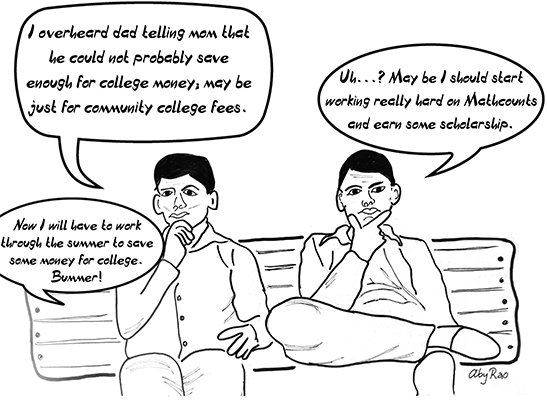
“At one or more times during our lives, most of us undergo a personal upheaval or crisis, which may or may not get resolved successfully through our making personal changes” – this was the observation of writer Jared Diamond in his book, Upheaval, released this past April.
Parents face the same sort of upheaval or dilemma when they start thinking about financing their children’s education. For sure any post-secondary education is getting to be very expensive for most of us and the worst part is that there is no let-up in sight. If I have to guess I would say don’t even look for that relief because it is not going to happen.
I don’t know any parents who have not thought about funding the higher education for their children and/or planning for it. Many even think about (some even go for it) using their retirement money to spend on child’s education. That is a mistake and it may sound harsh but nobody should think of doing that. The simple reason is that there are not too many alternatives for creating your retirement security other than what you may have saved yourself, but there are many funding options available to you and to your child for funding higher education. It is heartbreaking, but think about that and let it sink in.
The only option you have, if you are going to fund your child’s education, is to plan for it from the beginning, which means some sacrifice involved one way or the other. Many Asian families do just that right from the day the child is born; in fact you can start saving for it even before the child is born. Most common solution that is staring in our face is usually a 529k plan; it is a reasonably good plan but I have to admit I am usually not too thrilled about it.
Let us look at some hard dollar numbers to put this in perspective. Today, the cost of one year of tuition at a state University, like UNC Chapel Hill, for example, is about $9,018 for in-state students; that was for the year 2017-2018. If you include housing and meals and books and supplies then it will add up to $21,516. This is for the first year. If we assume a 6 percent inflation which is a common number used in calculations for college tuition fees, even though some schools have higher inlation, then the respective numbers for the next three years would be $22,807, $24,175 and $25,626. These numbers are good if your child is in college right now. If you are planning for the child who is just born then we will have to project these numbers to 18 years from now and they will be $61,414, $65,099, $69,005 and $73,145 respectively assuming the same inflation rate for the tuition as mentioned above.
That is how much funding you would need starting 18 years from now if you have to fund all of the education yourself. This gives us some sense of why there are so many students with such high loan burden. Projecting it back to today just for the first year we will have to save $176 per month for next 18 years to create that value assuming a 5 percent growth rate for all those 18 years. For four years together it will be putting away about $681 per month. That is a heavy burden on young parents and it is only for one child. The saving number will be even higher if you start saving after say when the child is 5 years old which means you only have 13 years to come up with that kind of savings; in that case you will have to put away $280 every month just for the first year of college. The 529k plans can be useful in some circumstances but they may not earn 5 percent growth rate and there is an upper limit as to how much you can invest in that plan every year.
Not all of us have this kind of ability. But then there are scholarships, Community Colleges which are less expensive and many other alternatives available to accommodate this cost. The only point I was making was that much advance planning (and perhaps some sacrifice) is necessary if we are indeed serious to support the child’s education. We haven’t even pondered post-graduation expenses like medical or doctorate programs.
It is not necessary that parents have to bear all the cost, in fact I suggest that let the student take on part of that responsibility (Summer/week-end jobs etc.) just to get an idea, if nothing else, on how difficult it is to put away that kind of savings. They appreciate the value of that money much more when their skin is in the game and they have to invest their own time, sweat and tears to support their own higher education.
There are many other options. Merit scholarships are there for which they will have to compete, which means work hard at it. There are many special scholarships available for which the student has to qualify to be eligible (some of these scholarships go unfilled because they cannot find the right candidates) and then there is just good old hard work and earning good grades (especially AP classes) and get some semesters freed up in the Freshman year. Every little bit counts.
Finally help from other relatives like aunts, uncles and grandparents could be available occasionally, even though nobody should depend on that. One tax advantage this arrangement has is if they pay the fees directly to the educational institute (and not to the student or the parents) then there is no estate tax implication of any sort for that payment, no matter how large it is.
———
Mo Vidwans is an independent, board-certified financial planner. For details visit www.vidwansfinancial.com, call +1 (984) 888-0355 or write to [email protected].



